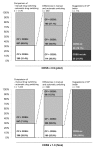Development and evaluation of a computerised clinical decision support system for switching drugs at the interface between primary and tertiary care
- PMID: 23185973
- PMCID: PMC3518241
- DOI: 10.1186/1472-6947-12-137
Development and evaluation of a computerised clinical decision support system for switching drugs at the interface between primary and tertiary care
Abstract
Background: Upon admission to a hospital patients' medications are frequently switched to alternative drugs compiled in so called hospital drug formularies. This substitution process is a laborious and error-prone task which should be supported by sophisticated electronic tools. We developed a computerised decision support system and evaluated benefit and potential harm associated with its use.
Methods: Based on a multi-step algorithm we identified drug classes suitable for exchange, defined conversion factors for therapeutic interchange, built a web-based decision support system, and implemented it into the computerised physician order entry of a large university hospital. For evaluation we compared medications manually switched by clinical pharmacists with the results of automated switching by the newly developed computer system and optimised the system in an iterative process. Thereafter the final system was tested in an independent set of prescriptions.
Results: After iterative optimisation of the logical framework the tool was able to switch drugs to pharmaceutical equivalents and alternatives; in addition, it contained 21 different drug classes for therapeutic substitution. In this final version it switched 91.6% of 202 documented medication consultations (containing 1,333 drugs) automatically, leaving 8.4% for manual processing by clinical professionals. No incorrect drug switches were found.
Conclusion: A large majority (>90%) of drug switches performed at the interface between primary and tertiary care can be handled automatically using electronic decision support systems, indicating that medication errors and workload of healthcare professionals can be considerably reduced.
Figures




References
-
- De Smet M. Drug formularies – good or evil? A view from the EEC. Cardiology. 1994;85(Suppl 1):41–45. - PubMed
Publication types
MeSH terms
Substances
LinkOut - more resources
Full Text Sources
Medical

